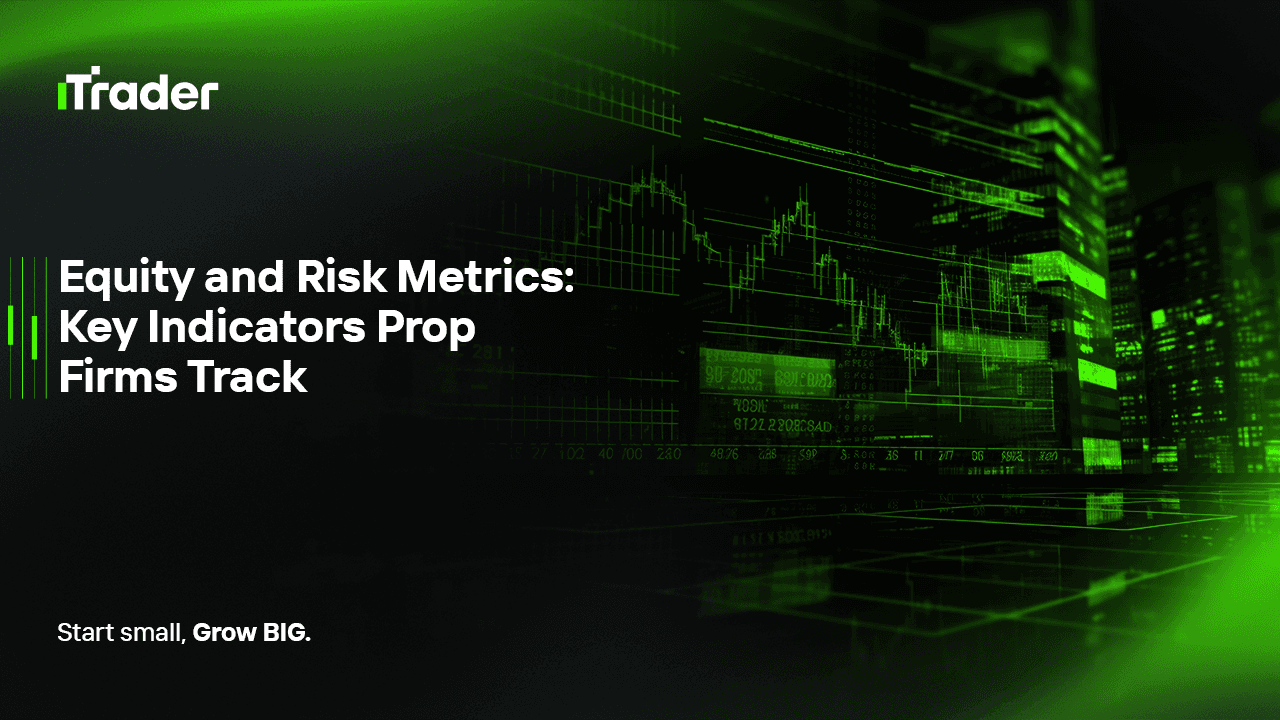2025-09-18
Every trader dreams of landing a funded account with a prop firm. The appeal is obvious: you get access to significant trading capital without risking your own money beyond the evaluation fee. But while most aspiring traders focus on how much profit they can make, prop firms are focused on something far more important: how you manage risk and equity over time.
Prop firms don’t just want traders who can hit a big profit target once. They want traders who can survive the long game. To them, it’s not about whether you can make 10% in a month — it’s about whether you can manage equity drawdowns, respect daily loss limits, and trade consistently without gambling. That’s why equity and risk metrics are at the very heart of every prop firm evaluation.

In this blog, we’ll explore the exact equity and risk metrics prop firms care about most. You’ll learn why these numbers matter, how they’re calculated, and how you can align your trading strategy with them to improve your chances of passing evaluations and keeping a funded account.
Let’s start with the basics.
Balance: This is the cash in your account excluding any open trades. If you closed all your trades right now, your balance is what you’d have.
Equity: This is your balance plus or minus any floating profit or loss from open positions.
Formula:
Equity = Balance + FloatingPnL
Example:
Equity = $10,000 + (300 – 100) = $10,200
Why prop firms care:
If your balance is $10,000 but your equity temporarily drops to $9,000 because of floating drawdown, a prop firm will count that $1,000 drop against your daily or maximum drawdown limits. In other words, equity is the true measure of risk, and it’s what firms monitor most closely.
Making money in the markets is only half the story. Without proper risk management, profits are temporary, and losses can wipe out accounts overnight. Prop firms know this, which is why their evaluations are designed to filter for traders who respect risk limits.
Risk metrics tell the firm:
These metrics don’t just matter for the evaluation stage — they’re also used once you’re funded. If you breach risk limits in a live account, your funding will be revoked, regardless of how profitable you were before.
Let’s go through the most common and important ones.
Example:
Starting balance: $100,000
Max DD limit: -$10,000
If your equity drops to $90,000 at any point, you fail the challenge.
Example:
Account: $100,000
Daily DD limit: -$5,000
If your equity drops below $95,000 on any given day — even for a second — the account is violated.
Prop firms know that one lucky trade doesn’t prove skill. That’s why they enforce rules around consistency:
Example rule: “No single trade can account for more than 30% of total profits.”
This ensures traders don’t bet big once and pray for a lucky outcome.
Example:
Passing a prop challenge isn’t just about hitting the profit target. It’s about respecting every single risk metric along the way.
Scenarios:
This is why traders who only focus on the profit target often fail challenges. Successful prop traders understand that risk metrics are the real test.
It’s worth noting that risk metrics aren’t just numbers — they’re psychological filters. Prop firms know:
By enforcing these rules, firms protect their capital and ensure only resilient, consistent traders move forward.
Equity and risk metrics form the backbone of prop firm evaluations. While many traders obsess over profit targets, the reality is that drawdowns, daily loss limits, consistency, and risk management matter far more. Prop firms aren’t searching for one-time winners — they’re searching for traders who can manage equity responsibly and perform sustainably in the long run.
If you want to succeed in prop trading, shift your mindset:
That’s the true path to not just passing evaluations, but keeping your funding and growing as a professional trader.
© 2025 iTrader Global Limited | 회사 등록번호: 15962
iTrader Global Limited는 코모로 연방 앙주앙 자치섬의 무잠두(Hamchako, Mutsamudu)에 위치하고 있으며, 코모로 증권위원회(Securities Commission of the Comoros)의 인가 및 규제를 받고 있습니다. 당사의 라이선스 번호는 L15962/ITGL입니다.
iTrader Global Limited는 “iTrader”라는 상호로 운영되며, 외환 거래 활동에 대한 인가를 받았습니다. 회사의 로고, 상표 및 웹사이트는 iTrader Global Limited의 독점 재산입니다.
iTrader Global Limited의 다른 자회사로는 iTrader Global Pty Ltd가 있으며, 이 회사는 호주 회사 등록번호(ACN): 686 857 198을 보유하고 있습니다. 해당 회사는 Opheleo Holdings Pty Ltd의 공식 대리인(AFS 대표 번호: 001315037)이며, Opheleo Holdings Pty Ltd는 호주 금융서비스 라이선스(AFSL 번호: 000224485)를 보유하고 있습니다. 등록 주소는 Level 1, 256 Rundle St, Adelaide, SA 5000입니다.
면책 조항: 이 회사는 본 웹사이트에서 거래되는 금융 상품의 발행인이 아니며 이에 대해 책임을 지지 않습니다.
위험 고지: 차액결제거래(CFD)는 레버리지로 인해 자본 손실이 빠르게 발생할 수 있는 높은 위험을 수반하며, 모든 사용자에게 적합하지 않을 수 있습니다.
펀드, CFD 및 기타 고레버리지 상품의 거래에는 전문적인 지식이 요구됩니다.
연구 결과에 따르면 레버리지 거래자의 84.01%가 손실을 경험하고 있습니다. 거래에 참여하기 전에 관련 위험을 충분히 이해하고 전체 자본을 잃을 준비가 되어 있는지 확인하십시오.
iTrader는 레버리지 거래로 인해 발생하는 손실, 위험 또는 기타 피해에 대해 개인 또는 법인에게 전적인 책임을 지지 않음을 명시합니다.
이용 제한: iTrader는 해당 활동이 법률, 규제 또는 정책에 따라 금지된 국가의 거주자를 대상으로 본 웹사이트나 서비스를 제공하지 않습니다.